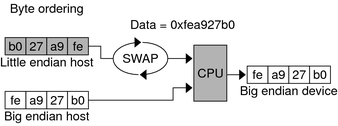| Skip Navigation Links | |
| Exit Print View | |

|
Writing Device Drivers Oracle Solaris 11.1 Information Library |
| Skip Navigation Links | |
| Exit Print View | |

|
Writing Device Drivers Oracle Solaris 11.1 Information Library |
Part I Designing Device Drivers for the Oracle Solaris Platform
1. Overview of Oracle Solaris Device Drivers
2. Oracle Solaris Kernel and Device Tree
5. Managing Events and Queueing Tasks
7. Device Access: Programmed I/O
10. Mapping Device and Kernel Memory
13. Hardening Oracle Solaris Drivers
14. Layered Driver Interface (LDI)
Part II Designing Specific Kinds of Device Drivers
15. Drivers for Character Devices
18. SCSI Host Bus Adapter Drivers
19. Drivers for Network Devices
Part III Building a Device Driver
22. Compiling, Loading, Packaging, and Testing Drivers
23. Debugging, Testing, and Tuning Device Drivers
24. Recommended Coding Practices
Member Alignment in SPARC Structures
SPARC Multiply and Divide Instructions
PCI Configuration Address Space
PCI Configuration Base Address Registers
PCI Hardware Configuration Files
SBus Hardware Configuration Files
B. Summary of Oracle Solaris DDI/DKI Services
C. Making a Device Driver 64-Bit Ready
To achieve the goal of multiple-platform, multiple-instruction-set architecture portability, host bus dependencies were removed from the drivers. The first dependency issue to be addressed was the endianness, that is, byte ordering, of the processor. For example, the x86 processor family is little-endian while the SPARC architecture is big-endian.
Bus architectures display the same endianness types as processors. The PCI local bus, for example, is little-endian, the SBus is big-endian, the ISA bus is little-endian, and so on.
To maintain portability between processors and buses, DDI-compliant drivers must be endian neutral. Although drivers can manage their endianness by runtime checks or by preprocessor directives like #ifdef _LITTLE_ENDIAN in the source code, long-term maintenance can be troublesome. In some cases, the DDI framework performs the byte swapping using a software approach. In other cases, byte swapping can be done by hardware page-level swapping as in memory management unit (MMU) or by special machine instructions. The DDI framework can take advantage of the hardware features to improve performance.
Figure A-1 Byte Ordering Required for Host Bus Dependency

Along with being endian-neutral, portable drivers must also be independent from data ordering of the processor. Under most circumstances, data must be transferred in the sequence instructed by the driver. However, sometimes data can be merged, batched, or reordered to streamline the data transfer, as illustrated in the following figure. For example, data merging can be applied to accelerate graphics display on frame buffers. Drivers have the option to advise the DDI framework to use other optimal data transfer mechanisms during the transfer.
Figure A-2 Data Ordering Host Bus Dependency
